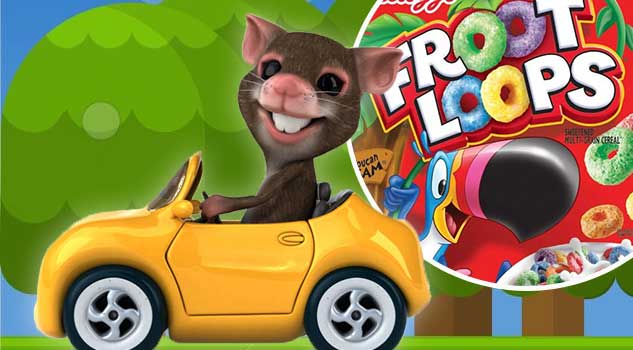Scientists Train Rats to Drive Tiny Cars to Earn Froot Loops
Look out, Seinfeld! Rats in “cars” are getting cereal—although they probably won’t launch their own web series any time soon. A research team from the University of Richmond taught a group of rats how to drive and steer small, rodent-sized cars to get Froot Loops.
The group published its astonishing study in the Behavioural Brain Research journal. Results showed a potentially positive impact on human mental health.
Cruising for Froot Loops
In the study, scientists from the University of Richmond’s Lambert Behavioral Neuroscience Laboratory trained two different groups of young rats. One group lived in an “enriched” environment with toys, balls, ladders, and wood that provided mental stimulation. The other group lived in a standard, no-frills lab cage.
The research team constructed a “rodent operated vehicle” (ROV) out of a clear, gallon-sized plastic jug. After entering the car, the rats stood on an aluminum plate. When they pressed a copper bar, it activated the wheels’ motor that propelled the ROV.
Three copper bars formed the “steering wheel.” To turn the car in different directions, the rats touched the right, left, and center bars.
Scientists placed bits of Froot Loops cereal at different points in the enclosure as a reward.
“They learned to navigate the car in unique ways and engaged in steering patterns they had never used to eventually arrive at the reward,” study author and laboratory head Kelly Lambert explained to New Scientist.
Notably, the rats that were raised with toys and other mental stimulants drove and steered the vehicle better than the group raised in the empty cage. Conversely, the unstimulated rodents “failed their driving test,” Lambert told CNN.
Throughout time, researchers learned that rats could press bars and navigate mazes. However, this study was the first to confirm that rodents could learn the more complex task of driving and steering a moving vehicle. Lambert advised that the “neuroplasticity” of the animals’ brains, which allows them to “respond flexibly to novel challenges,” enabled the rats to drive.
Human Stress Relieving Implications
Scientists made another surprising discovery in the study, which has human implications. Namely, learning to drive relaxed the rats. The team measured two different hormone levels in the rodents’ feces to draw this conclusion. One is corticosterone, which indicates stress, and the other is dehydroepiandrosterone, which counteracts it.
Overall, the ratio of dehydroepiandrosterone to corticosterone in the rats’ fecal matter increased throughout driving training. Consequently, mastering how to drive boosted the rodents’ emotional resilience.
“It is likely that driving gives the rats a sense of control over their environment,” Lambert said. “In humans, we would say that it enhances a sense of agency or self-efficacy.”
Humans’ brains are more complex than the rodents’ brains. However, according to Lambert, there are “universal truths” in how both species interact with an environment to maintain mental health. She maintained that discovering what kinds of behaviors can relieve stress and boost emotional resilience in humans could be vital in treating mental illnesses like depression. In this case, the rats were less stressed when driving.
Similarly, any task that engages someone’s hands (or in the rats’ case, paws), and brains like sewing, cooking, or learning to drive an ROV, can give the participant a sense of control.
Further Studies
Thanks to ongoing tech advances, scientific breakthroughs, and even space studies in low Earth orbit, research groups are constantly making all kinds of medical advances. Moving forward, Lambert hopes that scientists can use this new rodent driving test in other applications.
For instance, she suggested that researchers could measure the effects of Parkinson’s disease on motor skills and spatial awareness with the driving tests. Currently, the team plans to conduct follow up studies to understand better “how rats learn to drive, why it seems to reduce stress and which brain areas are involved.”
Source: The Burn-In
Share this:




